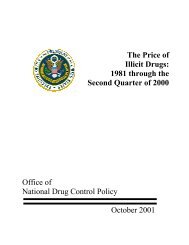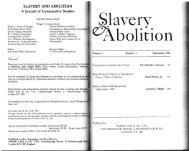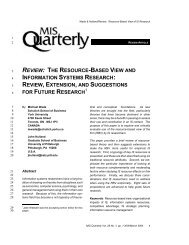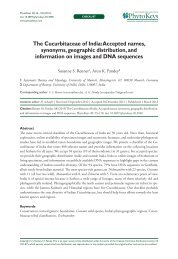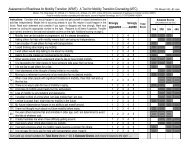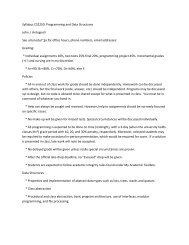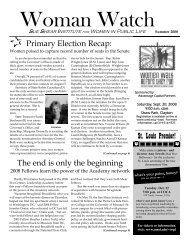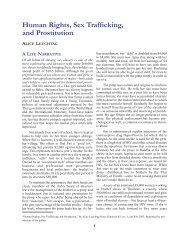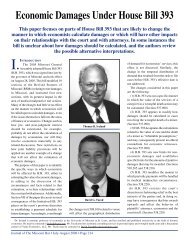an analysis of parole decision making using a sample of sex offenders
an analysis of parole decision making using a sample of sex offenders
an analysis of parole decision making using a sample of sex offenders
Create successful ePaper yourself
Turn your PDF publications into a flip-book with our unique Google optimized e-Paper software.
8 HUEBNER F.DOC 11/1/2006 8:49:12 AM<br />
PAROLE DECISION MAKING 971<br />
outcomes to race (Carroll <strong>an</strong>d Mondrick, 1976; Proctor, 1999; Scott, 1974).<br />
In this <strong>an</strong>alysis, minority race is a dichotomous measure with members <strong>of</strong><br />
<strong>an</strong>y minority group equal to one <strong>an</strong>d whites constituting the reference<br />
category. 4 Measures <strong>of</strong> education (number <strong>of</strong> years <strong>of</strong> schooling completed<br />
at the time <strong>of</strong> arrest) <strong>an</strong>d <strong>of</strong>fender age (measured in years at time <strong>of</strong> arrest)<br />
are also included. Because the study <strong>sample</strong> includes individuals with<br />
varied sentences, it was import<strong>an</strong>t to include a st<strong>an</strong>dardized measure <strong>of</strong><br />
time served. Time served signifies the percent <strong>of</strong> the maximum sentence<br />
(calculated in months) that has been served at time t.<br />
Offender blameworthiness. Considerations <strong>of</strong> <strong>of</strong>fender blameworthiness<br />
are legally established to help in evaluating the given criminal punishment<br />
relev<strong>an</strong>t to the perceived seriousness <strong>of</strong> the crime. As such, three<br />
dichotomous variables, including CSC 2 nd Degree, CSC 3 rd Degree, <strong>an</strong>d<br />
CSC 4 th<br />
Degree, are included in the models to account for the legal<br />
classification <strong>of</strong> the <strong>of</strong>fense that led to the current stay <strong>of</strong> imprisonment<br />
(1 = CSC 2 nd , CSC 3 rd , CSC 4 th Degree; 0 = CSC 1 st Degree). For men<br />
serving time for multiple convictions, the current <strong>of</strong>fense measure<br />
represents the most serious conviction. Multiple convictions (1 = <strong>of</strong>fender<br />
was convicted <strong>of</strong> multiple charges; 0 = <strong>of</strong>fender was convicted on only one<br />
charge) further increase assessments <strong>of</strong> <strong>of</strong>fender blameworthiness.<br />
In addition to legal classifications <strong>of</strong> culpability, blameworthiness c<strong>an</strong><br />
be mitigated by external attributions that may have influenced the<br />
<strong>of</strong>fender’s role in the event. Victimization has been identified as one factor<br />
that may mitigate <strong>of</strong>fender culpability (Steffensmeier <strong>an</strong>d Demuth, 2000),<br />
thereby reducing the time to <strong>parole</strong>. A binary measure <strong>of</strong> prior <strong>sex</strong>ual<br />
abuse is included in the model (1 = <strong>of</strong>fender reported being a victim <strong>of</strong><br />
criminal <strong>sex</strong>ual conduct in the past; 0 = <strong>of</strong>fender did not report being<br />
<strong>sex</strong>ual victimized).<br />
Community protection. The community protection model is primarily<br />
concerned with <strong>of</strong>fender deterrence <strong>an</strong>d incapacitation, particularly as it<br />
relates to reducing recidivism. The <strong>of</strong>ficial department <strong>of</strong> corrections<br />
<strong>parole</strong> readiness score serves as a central covariate in the model because<br />
researchers have identified institutional assessment tools as key<br />
determin<strong>an</strong>ts <strong>of</strong> <strong>parole</strong> release (Carroll, et al., 1982; Proctor, 1999) <strong>an</strong>d<br />
<strong>parole</strong> revocation (Winfree et al., 1990). The <strong>parole</strong> guidelines score is a<br />
seven-item weighted scale that combines measures <strong>of</strong> the current <strong>of</strong>fense,<br />
criminal record, institutional conduct, program participation, <strong>of</strong>fender age,<br />
mental status, <strong>an</strong>d institutional risk classification. Scores are solely<br />
4. Ideally, we would have liked to include separate measures <strong>of</strong> race <strong>an</strong>d ethnicity.<br />
The small number <strong>of</strong> Hisp<strong>an</strong>ic men <strong>an</strong>d respondents <strong>of</strong> other races or ethnicities<br />
precluded me<strong>an</strong>ingful <strong>an</strong>alyses. Overall, 22 percent <strong>of</strong> men were black, 3 percent<br />
were Hisp<strong>an</strong>ic, 1 percent were Americ<strong>an</strong> Indi<strong>an</strong>, <strong>an</strong>d 1 percent were <strong>an</strong>other race<br />
or ethnicity.




